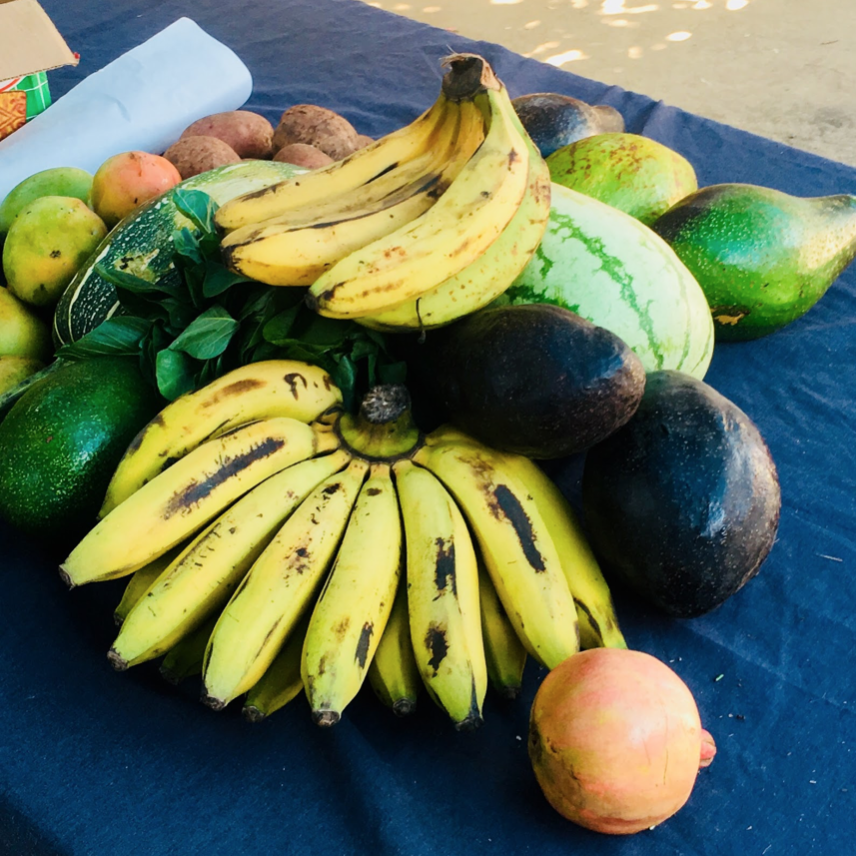GUEST BLOG BY TAYLOR WASHBURN AND EMILY CHANDLER, GLOBAL AMBASSADORS FOR ROCKFLOWER
On Saturday, July 21, 2018, we woke up in Kasese. Kasese is located in the southwest corner of Uganda, nestled between the Rwenzori Mountains and Queen Elizabeth National Park. The day before, we had left Bujagali Falls at 5AM with our driver, Michael, and Mama Ali’s youngest daughter, Muyombi Zahara. We had invited Zahara to join us after getting to know her during our stay with Mama Ali. She is 19 years old and a nursing student, with some free time before beginning her next semester. Due to her excitement about the projects and work that Rockflower invests in, we took the opportunity to expose her to more of the inspiring people and work happening in her country. We felt this was the least we could do, in return for all that Mama Ali’s family had done for us. We would soon learn, that our driver, Michael, would be much more than that for us. He taught us about the history and customs all throughout Uganda. He was there to help us navigate different situations, to act as a translator when needed, and he brought a keen eye for detail, noticing many things that Emily and I would have missed. Our trip was enriched beyond belief because of the relationship we were able to develop with Michael.
After a breakfast of eggs, toast, and fruit we were eager to begin our day. After all, this was why we were in Uganda: to meet with Rockflower partners and see the amazing and impactful work in which we are investing. The day was going to be a whirlwind with visits to three different partners. The first visit was with Hope for Rural Women (HORUWO), a community based, non-political, non-sectarian, non-profit-making organization. HORUWO is committed to the promotion of women’s and children’s rights, peace and justice, and ending domestic violence in rural communities, through education and health services.
We met Biira Juliet, the chair of HORUWO, and a member of her staff, Jolly, at 9:30AM. Both women were dressed in Gomesi, the traditional women’s dress of the Buganda and Busoga tribes. Gomesi are bright-colored dresses made from a silk or satin-like material with big cheerful patterns. They have a big sash and distinctive shoulders.
Juliet and Jolly guided us to a building that serves as HORUWO headquarters. There was a tall gate in front of the building which offered little suggestion of what was to greet us on the other side. As we stepped out of the van we were greeted by loud, joyous voices singing out over the enclosure. Suddenly the gate opened and dozens of members of HORUWO emerged from behind the gate, singing and dancing to welcome us to their home.
After making our way inside the gate we sat at a table in front of the group and they began the program that they had prepared for us. We were welcomed with more singing and then a report of the work they are doing. Similar to S.O.U.L., HORUWO takes a holistic approach and supports women on a number of fronts - health, economic empowerment, and education, to name a few. The presentation demonstrated how important this community has become for its members. One of their youngest members - Diana - had recently been accepted into a nursing and midwifery program. The pride emanating from the group was what you would expect of parents for their child. We were learning on this trip that family extends well beyond blood lines and that there is a reason the Ugandan people are known for their generosity.
Diana sang a touching song to the group, primarily women, about the strength and importance of mothers. In the midst of this song the group showered Diana with gifts of all types - notebooks, soap, corn flour to make posho, beans, a suitcase, and other necessities - so that she could begin school with all of the supplies she would need and more. Diana appeared a little overwhelmed by the generosity of this group, which was nothing compared to what we were soon to feel. Soon after Diana’s moment, the members of HORUWO processed up to the table and showered us with gifts. It was an incredible and overwhelming experience, knowing that they did not have much but were so eager to give something up to welcome us, complete strangers, to their home. Everything they gave us was beautifully wrapped in banana leaves, tied with banana fibers and decorated with pink bougainvillea. They were so pretty that it was a shame when they started opening them for us. We learned from Zahara that it is tradition to give visitors gifts, often from their garden.
We had traveled to Kasese in the midst of a drought. We learned this when we arrived at the hotel where we were staying, to find that there was no running water. Because of the drought, the water table had dropped to the extent that water was particularly scarce, even for the dry season, and could not be pumped into the hotel. Knowing this and then being given food from these women’s gardens was an incredibly powerful and humbling moment.
After more formalities, that included a few welcoming words from the elected official of the village, and some words from us about the work Rockflower does and why we were in Uganda, we were given a tour to see and really experience a small snapshot of the work that HORUWO is involved in. In their “office space,” where we met the group, they grow mushrooms and had planted a number of micro gardens. This space is more of a classroom than an office, as one of their projects is teaching women to grow food in less than ideal spaces. They have developed techniques using whatever is available - pots, empty tires and even plastic bags - to create spaces to grow vegetables. While this may have seemed very small scale, the impact of even such a small amount of independence is huge and empowering. One of the challenges that HORUWO faces iss working through circumstances that they cannot control. The current drought posed one such challenge, and the micro gardens mostly succumbed to it. After this introduction, we piled into the van with Michael and a number of members of HORUWO and set off to tour their other sites around Kasese.
At the first site we visited HORUWO grows vanilla. Vanilla is a very lucrative commodity, so they rent a house with a cement wall to protect the compound and their crop. A vanilla seedling costs under a dollar, while a mature vanilla vine can produce 1-2 kg of vanilla beans, which sell for approximately $90/kg. The vines themselves can also be sold for a similar amount. Much of the farming in Uganda is of the subsistence variety, in which families grow food to live on and any extra is taken to market to earn some money to purchase other necessities. HORUWO’s vanilla project is a bold step to go further. Many of the projects HORUWO undertakes require some level of capital to sustain them. HORUWO is thinking about how to make their work sustainable in a way that could eliminate the need for outside funding. With the profits from this project, HORUWO hopes to buy the house they are currently renting, so they continue to expand this project to support the other work they are doing. We were impressed with how forward thinking the group is. We were beginning to realize that the entrepreneurial spirit in Uganda is incredible. Just as they are working to empower their membership and teach independence, HORUWO is aware that it is necessary for their organization to become self-sustaining.
After the vanilla site, we headed a short way away to see their mushroom production. HORUWO uses a few rooms in the home of one of their members to grow mushrooms. The mushrooms are in bags hanging from the ceiling. Similar to the vanilla project, mushrooms offer an exciting opportunity as there can be a significant return on investment. Because of the drought and the hot dry conditions the mushrooms were dormant, but there was hope that as the season changes from dry to wet (usually in August) the project would take off. For us, this project highlighted how important it is for these groups to diversify the work that they do. It also shows just how powerful a collective group can be. As individuals, none of these women could afford to invest in multiple cash crops like this; not only do they not have the time, but they don’t have the space or resources. However, when they are able to pool their resources and share the workload, the opportunities are amplified.
Our last stop was a third property that is owned by one of the HORUWO members. When we stepped out of the van, we saw rows upon rows of coffee seedlings. While Ugandans don’t drink much coffee, they are well aware of its popularity elsewhere and the potential revenue that can come from growing it. HORUWO probably has 20,000 coffee seedlings growing in little plastic bags which they will tend until they are more mature before selling them at a significant profit. It was exciting for us to see how resourceful these women are and the different projects they had.
After a very busy morning with HORUWO, we were still feeling overwhelmed by all we had seen and experienced with them. We thanked Juliet, Jolly and the HORUWO members for their generosity, effort and time in hosting us and sharing their work with us. A longtime Rockflower partner, we would see the HORUWO leadership again at our meeting with 50+ community-based organizations and potential Rockflower partners in the Kasese region the next day. Seeing the work HORUWO is doing, and the potential for it to expand and become self-sustaining, added to our understanding of what is necessary for community organizations like these to empower women and communities through economic opportunities.








